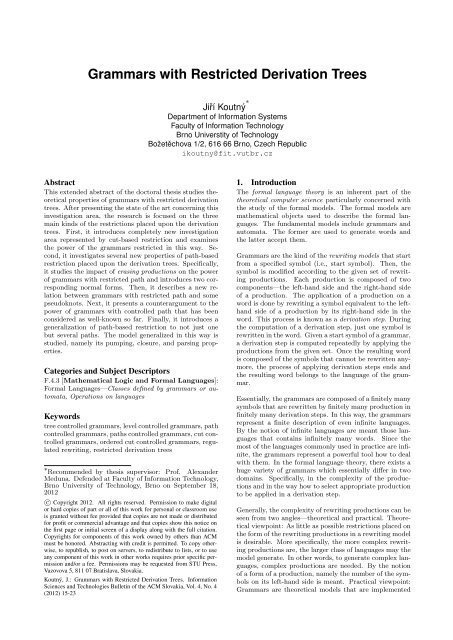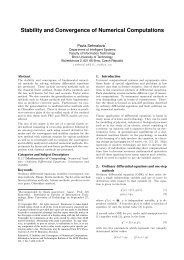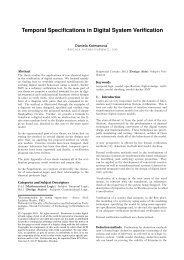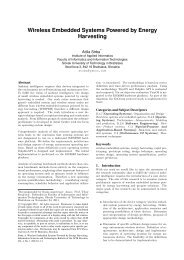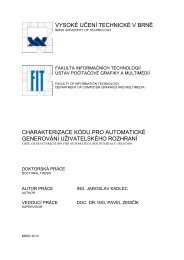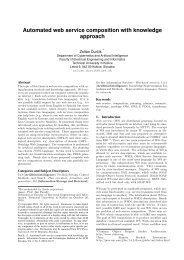Grammars with Restricted Derivation Trees - Bulletin of the ACM ...
Grammars with Restricted Derivation Trees - Bulletin of the ACM ...
Grammars with Restricted Derivation Trees - Bulletin of the ACM ...
You also want an ePaper? Increase the reach of your titles
YUMPU automatically turns print PDFs into web optimized ePapers that Google loves.
<strong>Grammars</strong> <strong>with</strong> <strong>Restricted</strong> <strong>Derivation</strong> <strong>Trees</strong>Jiří Koutný ∗Department <strong>of</strong> Information SystemsFaculty <strong>of</strong> Information TechnologyBrno Universtity <strong>of</strong> TechnologyBožetěchova 1/2, 616 66 Brno, Czech Republicikoutny@fit.vutbr.czAbstractThis extended abstract <strong>of</strong> <strong>the</strong> doctoral <strong>the</strong>sis studies <strong>the</strong>oreticalproperties <strong>of</strong> grammars <strong>with</strong> restricted derivationtrees. After presenting <strong>the</strong> state <strong>of</strong> <strong>the</strong> art concerning thisinvestigation area, <strong>the</strong> research is focused on <strong>the</strong> threemain kinds <strong>of</strong> <strong>the</strong> restrictions placed upon <strong>the</strong> derivationtrees. First, it introduces completely new investigationarea represented by cut-based restriction and examines<strong>the</strong> power <strong>of</strong> <strong>the</strong> grammars restricted in this way. Second,it investigates several new properties <strong>of</strong> path-basedrestriction placed upon <strong>the</strong> derivation trees. Specifically,it studies <strong>the</strong> impact <strong>of</strong> erasing productions on <strong>the</strong> power<strong>of</strong> grammars <strong>with</strong> restricted path and introduces two correspondingnormal forms. Then, it describes a new relationbetween grammars <strong>with</strong> restricted path and somepseudoknots. Next, it presents a counterargument to <strong>the</strong>power <strong>of</strong> grammars <strong>with</strong> controlled path that has beenconsidered as well-known so far. Finally, it introduces ageneralization <strong>of</strong> path-based restriction to not just onebut several paths. The model generalized in this way isstudied, namely its pumping, closure, and parsing properties.Categories and Subject DescriptorsF.4.3 [Ma<strong>the</strong>matical Logic and Formal Languages]:Formal Languages—Classes defined by grammars or automata,Operations on languagesKeywordstree controlled grammars, level controlled grammars, pathcontrolled grammars, paths controlled grammars, cut controlledgrammars, ordered cut controlled grammars, regulatedrewriting, restricted derivation trees∗ Recommended by <strong>the</strong>sis supervisor: Pr<strong>of</strong>. AlexanderMeduna. Defended at Faculty <strong>of</strong> Information Technology,Brno University <strong>of</strong> Technology, Brno on September 18,2012c⃝ Copyright 2012. All rights reserved. Permission to make digitalor hard copies <strong>of</strong> part or all <strong>of</strong> this work for personal or classroom useis granted <strong>with</strong>out fee provided that copies are not made or distributedfor pr<strong>of</strong>it or commercial advantage and that copies show this notice on<strong>the</strong> first page or initial screen <strong>of</strong> a display along <strong>with</strong> <strong>the</strong> full citation.Copyrights for components <strong>of</strong> this work owned by o<strong>the</strong>rs than <strong>ACM</strong>must be honored. Abstracting <strong>with</strong> credit is permitted. To copy o<strong>the</strong>rwise,to republish, to post on servers, to redistribute to lists, or to useany component <strong>of</strong> this work in o<strong>the</strong>r works requires prior specific permissionand/or a fee. Permissions may be requested from STU Press,Vazovova 5, 811 07 Bratislava, Slovakia.Koutný, J.: <strong>Grammars</strong> <strong>with</strong> <strong>Restricted</strong> <strong>Derivation</strong> <strong>Trees</strong>. InformationSciences and Technologies <strong>Bulletin</strong> <strong>of</strong> <strong>the</strong> <strong>ACM</strong> Slovakia, Vol. 4, No. 4(2012) 15-231. IntroductionThe formal language <strong>the</strong>ory is an inherent part <strong>of</strong> <strong>the</strong><strong>the</strong>oretical computer science particularly concerned <strong>with</strong><strong>the</strong> study <strong>of</strong> <strong>the</strong> formal models. The formal models arema<strong>the</strong>matical objects used to describe <strong>the</strong> formal languages.The fundamental models include grammars andautomata. The former are used to generate words and<strong>the</strong> latter accept <strong>the</strong>m.<strong>Grammars</strong> are <strong>the</strong> kind <strong>of</strong> <strong>the</strong> rewriting models that startfrom a specified symbol (i.e., start symbol). Then, <strong>the</strong>symbol is modified according to <strong>the</strong> given set <strong>of</strong> rewritingproductions. Each production is composed <strong>of</strong> twocomponents—<strong>the</strong> left-hand side and <strong>the</strong> right-hand side<strong>of</strong> a production. The application <strong>of</strong> a production on aword is done by rewriting a symbol equivalent to <strong>the</strong> lefthandside <strong>of</strong> a production by its right-hand side in <strong>the</strong>word. This process is known as a derivation step. During<strong>the</strong> computation <strong>of</strong> a derivation step, just one symbol isrewritten in <strong>the</strong> word. Given a start symbol <strong>of</strong> a grammar,a derivation step is computed repeatedly by applying <strong>the</strong>productions from <strong>the</strong> given set. Once <strong>the</strong> resulting wordis composed <strong>of</strong> <strong>the</strong> symbols that cannot be rewritten anymore,<strong>the</strong> process <strong>of</strong> applying derivation steps ends and<strong>the</strong> resulting word belongs to <strong>the</strong> language <strong>of</strong> <strong>the</strong> grammar.Essentially, <strong>the</strong> grammars are composed <strong>of</strong> a finitely manysymbols that are rewritten by finitely many production infinitely many derivation steps. In this way, <strong>the</strong> grammarsrepresent a finite description <strong>of</strong> even infinite languages.By <strong>the</strong> notion <strong>of</strong> infinite languages are meant those languagesthat contains infinitely many words. Since <strong>the</strong>most <strong>of</strong> <strong>the</strong> languages commonly used in practice are infinite,<strong>the</strong> grammars represent a powerful tool how to deal<strong>with</strong> <strong>the</strong>m. In <strong>the</strong> formal language <strong>the</strong>ory, <strong>the</strong>re exists ahuge variety <strong>of</strong> grammars which essentially differ in twodomains. Specifically, in <strong>the</strong> complexity <strong>of</strong> <strong>the</strong> productionsand in <strong>the</strong> way how to select appropriate productionto be applied in a derivation step.Generally, <strong>the</strong> complexity <strong>of</strong> rewriting productions can beseen from two angles—<strong>the</strong>oretical and practical. Theoreticalviewpoint: As little as possible restrictions placed on<strong>the</strong> form <strong>of</strong> <strong>the</strong> rewriting productions in a rewriting modelis desirable. More specifically, <strong>the</strong> more complex rewritingproductions are, <strong>the</strong> larger class <strong>of</strong> languages may <strong>the</strong>model generate. In o<strong>the</strong>r words, to generate complex languages,complex productions are needed. By <strong>the</strong> notion<strong>of</strong> a form <strong>of</strong> a production, namely <strong>the</strong> number <strong>of</strong> <strong>the</strong> symbolson its left-hand side is meant. Practical viewpoint:<strong>Grammars</strong> are <strong>the</strong>oretical models that are implemented
Information Sciences and Technologies <strong>Bulletin</strong> <strong>of</strong> <strong>the</strong> <strong>ACM</strong> Slovakia, Vol. 4, No. 4 (2012) 15-23 17basic properties <strong>of</strong> tree controlled grammars—namely, <strong>the</strong>membership problem and <strong>the</strong> power.Based on <strong>the</strong> original definition <strong>of</strong> a tree controlled grammar,Păun studies <strong>the</strong> modifications where many wellknowntypes <strong>of</strong> both controlled grammars and control languagesare considered in [33]. More precisely, Păun studiescontrolling <strong>the</strong> levels <strong>of</strong> <strong>the</strong> derivation trees <strong>of</strong> a regulargrammar by several types <strong>of</strong> a control language, controlling<strong>the</strong> levels <strong>of</strong> <strong>the</strong> derivation trees <strong>of</strong> a context-freegrammar <strong>with</strong>out erasing productions by several types <strong>of</strong>a control language, and controlling <strong>the</strong> levels <strong>of</strong> <strong>the</strong> derivationtrees <strong>of</strong> a context-free grammar by a finite language.It is well-known that tree controlled grammars <strong>with</strong> acontext-free grammar controlled by a regular languagecharacterize <strong>the</strong> class <strong>of</strong> recursively enumerable languages.Thus, <strong>the</strong> question arises whe<strong>the</strong>r or not it is possible toachieve <strong>the</strong> same power as tree controlled grammars havewhen <strong>the</strong> levels <strong>of</strong> <strong>the</strong> derivation trees are restricted by asubregular control language. This problem is studied byDassow and Tru<strong>the</strong> in [13], where many types <strong>of</strong> subregularlanguages are considered. Dassow and Tru<strong>the</strong> studyprimarily controlling <strong>the</strong> levels <strong>of</strong> <strong>the</strong> derivation trees <strong>of</strong>a context-free grammar by two types <strong>of</strong> a language suchthat one is a subset <strong>of</strong> <strong>the</strong> o<strong>the</strong>r and controlling <strong>the</strong> levels<strong>of</strong> <strong>the</strong> derivation trees <strong>of</strong> a context-free grammar bymany different types <strong>of</strong> subregular languages. The sameauthors, Dassow and Tru<strong>the</strong>, also study hierarchies <strong>of</strong>subregularly tree controlled languages in [11] and [12].They present controlling <strong>the</strong> levels <strong>of</strong> <strong>the</strong> derivation trees<strong>of</strong> a context-free grammar by <strong>the</strong> union <strong>of</strong> monoids, byregular languages <strong>with</strong> restricted descriptional complexity,and by <strong>the</strong> language accepted by a deterministic finiteautomaton <strong>with</strong> at most given number <strong>of</strong> states.Stiebe in [40] states that <strong>the</strong>re is a tree controlled grammarfor every linearly bounded queue automaton. Then,Stiebe proves that controlling <strong>the</strong> levels <strong>of</strong> <strong>the</strong> derivationtrees <strong>of</strong> a context-free grammar by <strong>the</strong> language acceptedby a minimal finite automaton <strong>with</strong> at most five statescharacterize <strong>the</strong> class <strong>of</strong> context-sensitive languages. If,additionally, erasing productions in a controlled grammarare allowed, controlling <strong>the</strong> levels <strong>of</strong> <strong>the</strong> derivation trees<strong>of</strong> a context-free grammar by <strong>the</strong> language accepted by aminimal finite automaton <strong>with</strong> at most five states characterizes<strong>the</strong> class <strong>of</strong> recursively enumerable languages.Turaev, Dassow, and Selamat in [41] examine tree controlledgrammars <strong>with</strong> bounded nonterminal complexityand demonstrate that seven nonterminals in a tree controlledgrammar are enough to generate any recursivelyenumerable language. Then, <strong>the</strong>y establish that threenonterminals in a tree controlled grammar are enoughto generate any regular language and any regular simplematrix language can be generated by a tree controlledgrammar <strong>with</strong> three nonterminals. Finally, <strong>the</strong>y demonstratethat three nonterminals in a tree controlled grammarare enough to generate any linear language. Thesame authors in [42] state several fur<strong>the</strong>r nonterminalcomplexity-relatedproperties <strong>of</strong> tree controlled grammars.2.2 Path Based RestrictionAs an attempt to increase <strong>the</strong> power <strong>of</strong> context-free grammars<strong>with</strong>out changing <strong>the</strong> basic formalism and loosingsome basic properties <strong>of</strong> context-free languages (decidability,efficient parsing, etc.), Marcus, Martín-Vide, Mitrana,and Păun in [26] study a new type <strong>of</strong> a restrictionin a derivation: a derivation tree in a context-free grammaris accepted if it contains a path described by a controllanguage. More precisely, <strong>the</strong>y consider two context-freegrammars, G and G ′ . A word, w, generated by G belongsto <strong>the</strong> language defined by G and G ′ if <strong>the</strong>re is a derivationtree, t, for w in G such that <strong>the</strong>re exists a path <strong>of</strong>t described by <strong>the</strong> language <strong>of</strong> G ′ . Based on this restriction,<strong>the</strong>y introduce a path controlled grammar and studyseveral properties <strong>of</strong> this model. Specifically, <strong>the</strong>y studycontrolling a path <strong>of</strong> <strong>the</strong> derivation trees <strong>of</strong> several types<strong>of</strong> grammars by a regular language and controlling a path<strong>of</strong> <strong>the</strong> derivation trees <strong>of</strong> a regular grammar by a linear orcontext-free language. Then, <strong>the</strong>y establish two kinds <strong>of</strong>pumping properties depending on <strong>the</strong> type <strong>of</strong> a controlledgrammar, some consequences to <strong>the</strong> closure properties <strong>of</strong>path controlled grammars, and a basic parsing propertyfor path controlled grammars. They also investigate <strong>the</strong>power <strong>of</strong> path controlled grammars. However, <strong>the</strong>re existsa serious problem <strong>with</strong> <strong>the</strong> correctness <strong>of</strong> <strong>the</strong> pro<strong>of</strong> <strong>the</strong>ypresent.As a continuation <strong>of</strong> <strong>the</strong> investigation <strong>of</strong> path-based restrictions,Martín-Vide and Mitrana study parsing properties<strong>of</strong> path controlled grammars, closure properties <strong>of</strong>path controlled grammars, and several decision problemsfor path controlled grammars in [27] and [28].2.3 Goals <strong>of</strong> <strong>the</strong> ThesisAs it clearly follows from <strong>the</strong> previous sections, levelbasedrestriction is well-studied and <strong>the</strong> most <strong>of</strong> <strong>the</strong> importantquestions have been answered. On <strong>the</strong> o<strong>the</strong>rhand, in <strong>the</strong> case <strong>of</strong> path-based restriction many basicproperties including <strong>the</strong> generative power have not beensuccessfully investigated yet. Moreover, several o<strong>the</strong>r restrictionsplaced upon <strong>the</strong> derivation trees have not yetbeen introduced at all. Indeed, <strong>the</strong> restrictions placedupon <strong>the</strong> cuts <strong>of</strong> <strong>the</strong> derivation tree as well as upon severalpaths <strong>of</strong> <strong>the</strong> derivation trees represent completely newinvestigation areas. Thus, <strong>the</strong> goals <strong>of</strong> <strong>the</strong> doctoral <strong>the</strong>sisconsist in three investigation areas.• First, to introduce new investigation area representedby cut-based restrictions and establish <strong>the</strong> generativepower <strong>of</strong> <strong>the</strong> model restricted in this way.• Second, to establish several new results in <strong>the</strong> investigation<strong>of</strong> one-path-restricted grammars introducedin [26].• Third, to generalize one-path-restricted model intoseveral paths and investigate several its properties.3. New Results in Restrictions Placed upon <strong>Derivation</strong><strong>Trees</strong>First we reformulate <strong>the</strong> fundamental definitions so thatall derivation-tree-based restrictions can be studied using<strong>the</strong> same notation. Then, we present new results in <strong>the</strong>derivation-tree based restrictions investigation area.Since restriction placed upon a level, a path, and a cut is,in essence, a restriction placed upon a derivation tree, weuse a slightly modified but equivalent formulation <strong>of</strong> <strong>the</strong>definitions stated in [26], [27], and [28]. Consequently,aforementioned modifications allow us to investigate allderivation-tree-based restrictions using <strong>the</strong> same terminology—i.e.,restriction on <strong>the</strong> levels (see [9], [13], [33],
Information Sciences and Technologies <strong>Bulletin</strong> <strong>of</strong> <strong>the</strong> <strong>ACM</strong> Slovakia, Vol. 4, No. 4 (2012) 15-23 19ord-cut-TC(CF, REG) = { ord-cut L(G, R) : (G, R) isa tree controlled grammar in which G is a context-freegrammar and R ∈ REG} and <strong>the</strong> class <strong>of</strong> tree controlledlanguages <strong>with</strong> ε-free controlled grammar under orderedcuts control is defined asord-cut-TC ε(CF ε, REG) = { ord-cut L(G, R) : (G, R) isa tree controlled grammar in which G is an ε-free contextfreegrammar and R ∈ REG}.3.1.2 ResultsConcerning cut-based restriction placed upon <strong>the</strong> derivationtrees, we have introduced two fundamental types <strong>of</strong>such kind <strong>of</strong> a restriction and thus, we have opened anew investigation area in derivation-tree-restricted models.Next, we have proved that both restrictions increase<strong>the</strong> power <strong>of</strong> context-free grammars so <strong>the</strong>y characterizeRE:ord-cut-TC(CF, REG) = cut-TC(CF, REG) = RE.An important open problem consists <strong>of</strong> <strong>the</strong> investigation<strong>of</strong> cut controlled grammars where ε-productions are forbidden.Consequently, <strong>the</strong> grammars restricted in thisway should be placed into <strong>the</strong> relation <strong>with</strong> some o<strong>the</strong>rwell-known language families, such as CS, and <strong>the</strong> deciding<strong>the</strong> question whe<strong>the</strong>r or not:ord-cut-TC ε(CF ε, REG) = CS,cut-TC ε (CF ε , REG) = CS.Next problem is represented by <strong>the</strong> descriptional complexity<strong>of</strong> ord-cut-TC(CF, REG) and cut-TC(CF, REG).The results presented above are based on <strong>the</strong> transformation<strong>of</strong> an unrestricted grammar into Pentonnen normalform. However, using Geffert normal form, <strong>the</strong> number<strong>of</strong> nonterminals in <strong>the</strong> resulting cut controlled grammarwould be reduced.Ano<strong>the</strong>r future research idea is represented by <strong>the</strong> controlling<strong>the</strong> cuts <strong>of</strong> <strong>the</strong> derivation trees in which severaltypes <strong>of</strong> subregular control languages are considered. Inthis way, <strong>the</strong> question whe<strong>the</strong>r or not a kind <strong>of</strong> a subregurallanguage is enough to increase <strong>the</strong> power <strong>of</strong> controlledgrammar properly. Consequently, <strong>the</strong> relation between<strong>the</strong> power <strong>of</strong> level-based and cut-based models restrictedin this way would be founded out.3.2 Path Based RestrictionIn this section, we introduce a path-based restriction ontree-controlled grammars that is equivalent to <strong>the</strong> modelintroduced in [26], [27], and [28]. Next, we formally define<strong>the</strong> pseudoknot structure represented as a language. Weintroduce new results related to <strong>the</strong> normal forms and <strong>the</strong>presence <strong>of</strong> erasing productions in a controlled grammar.Then, this section presents a relationship between biologyand <strong>the</strong> formal language <strong>the</strong>ory in <strong>the</strong> form <strong>of</strong> word representation<strong>of</strong> pseudoknots generated by path controlledgrammars. Last section <strong>of</strong> this part being a counterargumentagainst <strong>the</strong> pro<strong>of</strong> <strong>of</strong> <strong>the</strong> power <strong>of</strong> path controlledgrammars that has been considered as correct so far.3.2.1 DefinitionsDefinition 3.13. Let (G, R) be a tree controlled grammar.The language that (G, R) generates under <strong>the</strong> pathcontrol by R is denoted by path L(G, R) and defined by <strong>the</strong>following equivalence:For all x ∈ T ∗ , x ∈ path L(G, R) if and only if <strong>the</strong>reis a derivation tree, t ∈ G△(x), such that <strong>the</strong>re is a path,p, <strong>of</strong> t <strong>with</strong> word(p) ∈ R.Definition 3.14. For X, Y ∈ {LIN, CF}, <strong>the</strong> class <strong>of</strong>tree controlled languages under <strong>the</strong> path control is definedaspath-TC(X, Y) = { path L(G, R) : (G, R) is a tree controlledgrammar in which G ∈ G X and R ∈ Y} and <strong>the</strong>class <strong>of</strong> tree controlled languages <strong>with</strong> ε-free controlledgrammar under path control is defined aspath-TC ε (CF ε, Y) = { path L(G, R) : (G, R) is a treecontrolled grammar in which G is an ε-free context-freegrammar and R ∈ Y}.Definition 3.15. Let (G, R) be a tree controlled grammarthat generates <strong>the</strong> language under path control by R,where G = (V, T, P, S). (G, R) is in 1 st normal form ifevery production, r : A → x ∈ P , is <strong>of</strong> <strong>the</strong> form A ∈ V −Tand x ∈ T ∪ (V − T ) ∪ (V − T ) 2 .Definition 3.16. Let (G, R) be a tree controlled grammarthat generates <strong>the</strong> language under path control by R,where G = (V, T, P, S). (G, R) is in 2 nd normal form ifevery production, r : A → x ∈ P , is <strong>of</strong> <strong>the</strong> form A ∈ V −Tand x ∈ T ∪ ((V ∪ {E}) − T ) 2 where E ∩ V = ∅ andE → ε ∈ P . The alphabet <strong>of</strong> G should now include E,<strong>with</strong> E ∉ V .Definition 3.17. Let Σ be an alphabet. The followinglanguages over Σ are pseudoknots:1. {xyx R y R : x, y ∈ Σ ∗ },{u 1xu 2yu 3x R u 4y R u 5 : x, y, u i ∈ Σ ∗ , 1 ≤ i ≤ 5},2. {xyx R zz R y R : x, y, z ∈ Σ ∗ },{u 1xu 2yu 3x R u 4zu 5z R u 6y R u 7 : x, y, z, u i ∈ Σ ∗ , 1 ≤i ≤ 7},3. {xyx R zy R z R : x, y, z ∈ Σ ∗ },{u 1xu 2yu 3x R u 4zu 5y R u 6z R u 7 : x, y, z, u i ∈ Σ ∗ , 1 ≤i ≤ 7},4. {xyzx R y R z R : x, y, z ∈ Σ ∗ },{u 1xu 2yu 3zu 4x R u 5y R u 6z R u 7 : x, y, z, u i ∈ Σ ∗ , 1 ≤i ≤ 7}.Note that presented pseudoknots form obviously non-context-freelanguages.3.2.2 ResultsAs a continuation <strong>of</strong> <strong>the</strong> investigation <strong>of</strong> path-based restrictionsintroduced in [26] and studied in [27] and [28],we have considered <strong>the</strong> impact <strong>of</strong> ε-productions in pathcontrolled grammars to <strong>the</strong> power and we have statedthat ε-productions can be removed from a path controlledgrammar <strong>with</strong>out affecting its language:path-TC(CF, CF) = path-TC ε (CF ε , CF).
20 Koutný, J.: <strong>Grammars</strong> <strong>with</strong> <strong>Restricted</strong> <strong>Derivation</strong> <strong>Trees</strong>We have established two Chomsky-like normal forms forpath controlled grammars and we have formulated algorithmsthat transform a path controlled grammar into itsnormal form:• Let L ∈ path-TC(CF, CF). Then, <strong>the</strong>re existsa tree controlled grammar, (G, R), in 1 st normalform such that L = path L(G, R).• Let L ∈ path-TC(CF, CF). Then, <strong>the</strong>re existsa tree controlled grammar, (G, R), in 2 nd normalform such that L = path L(G, R).A future investigation idea consists <strong>of</strong> <strong>the</strong> modifying ageneral parsing methods that are based on Chomsky normalform such that it will be able to parse path controlledgrammars in a polynomial time.Ano<strong>the</strong>r practically motivated idea is represented <strong>the</strong> relationbetween path controlled grammars and <strong>the</strong> <strong>the</strong>ory<strong>of</strong> pseudoknots. We have demonstrated several typicalpseudoknots used in biology represented by <strong>the</strong> words <strong>of</strong>non-context-free languages. We have demonstrated somepseudoknots belong to path-TC(LIN, LIN):{xyx R y R : x, y ∈ Σ ∗ } ∈ path-TC(LIN, LIN),{xyx R zz R y R : x, y, z ∈ Σ ∗ } ∈ path-TC(LIN, LIN),{xyx R zy R z R : x, y, z ∈ Σ ∗ } ∈ path-TC(LIN, LIN).Apparently, <strong>the</strong>re is a huge variety <strong>of</strong> ano<strong>the</strong>r pseudoknotstructures in biology. For example, {xyzx R y R z R :x, y, z ∈ Σ ∗ } and it is an open question whe<strong>the</strong>r or notthose pseudoknots can be generated by tree controlledgrammars <strong>with</strong> linear components that generate <strong>the</strong> languageunder path control.The last presented result deals <strong>with</strong> a reflection on <strong>the</strong>power <strong>of</strong> path controlled grammars that has been consideredas well-known (see [26]) for more than last tenyears. However, we have presented an argument against<strong>the</strong> correctness <strong>of</strong> <strong>the</strong> pro<strong>of</strong> given in [26] that statespath-TC(CF, CF) ⊆ MAT.We have concluded <strong>the</strong> counterargument by stating that<strong>the</strong> aforementioned inclusion still may hold; however, itcannot be proved in <strong>the</strong> way given in [26]. More precisely,we have found <strong>the</strong> language tha can be generated by agrammar <strong>with</strong> controlled path. However, this languagecannot be generated by <strong>the</strong> grammar obtained by <strong>the</strong>construction introduced in [26]. Apparently, <strong>the</strong> power<strong>of</strong> path controlled grammar still represents an open problem.3.3 Several Paths Based RestrictionThis section being a generalization <strong>of</strong> path-restricted rewritingmodel to a restriction placed upon not just onebut several paths. Then, it presents several properties <strong>of</strong><strong>the</strong> model restricted in this way. Specifically, <strong>the</strong> power <strong>of</strong>a kind <strong>of</strong> all-paths-restricted rewriting model, closure andpumping properties in relation to <strong>the</strong> number <strong>of</strong> controlledpaths, and <strong>the</strong> approximation <strong>of</strong> <strong>the</strong> power for n-pathrestricted model. The last section <strong>of</strong> this part presents anapplication related result concerning <strong>the</strong> parsing <strong>of</strong> pathrestricted languages.3.3.1 DefinitionsDefinition 3.18. Let (G, R) be a tree controlled grammar.The language that (G, R) generates under <strong>the</strong> allpathscontrol by R is denoted by all-paths L(G, R) and definedby <strong>the</strong> following equivalence:For all x ∈ T ∗ , x ∈ all-paths L(G, R) if and only if<strong>the</strong>re is a derivation tree, t ∈ G △(x), such that for allpaths, s, <strong>of</strong> t, word(s) ∈ R.Definition 3.19. The class <strong>of</strong> tree controlled languagesunder all paths control is defined asall-path-TC(CF, REG) = { all-paths L(G, R) : (G, R) isa tree controlled grammar in which G is a context-freegrammar and R ∈ REG}.Definition 3.20. Let (G, R) be a tree controlled grammar.The language <strong>of</strong> tree controlled grammar undernot common n-path control by R, n ≥ 1, is denoted bync-n-pathL(G, R) and defined by <strong>the</strong> following equivalence:For all x ∈ T ∗ , x ∈ nc-n-path L(G, R) if <strong>the</strong>re existsa derivation tree, t ∈ G △(x), such that <strong>the</strong>re is a set, Q t ,<strong>of</strong> n paths <strong>of</strong> t such that for each path, p ∈ Q t , word(p) ∈R.Definition 3.21. For X, Y ∈ {REG, LIN, CF}, <strong>the</strong>class <strong>of</strong> tree controlled languages under not-common n-path control is defined asnc-n-path-TC(X, Y) = { nc-n-path L(G, R) : (G, R) isa tree controlled grammar <strong>with</strong> G ∈ G X and R ∈ Y}.Definition 3.22. Let p 1 , p 2 be any different two paths<strong>of</strong> a derivation tree, t. Then, p 1 and p 2 contain at leastone common node (<strong>the</strong> root <strong>of</strong> t, root(t)), and p 1 ends ina different leaf <strong>of</strong> t than p 2. Let cmn(p 1, p 2) denote <strong>the</strong>maximal number <strong>of</strong> consecutive common nodes <strong>of</strong> p 1 andp 2.Definition 3.23. Let Q t be a nonempty set <strong>of</strong> somepaths <strong>of</strong> a derivation tree, t. The paths <strong>of</strong> Q t are dividedin a common node <strong>of</strong> t if and only if for some k ≥ 1,cmn(p 1, p 2) = k for every pair (p 1, p 2) ∈ Q 2 t . Let all paths<strong>of</strong> Q t be divided in a common node <strong>of</strong> t. If Q t = {p},<strong>the</strong>n m Qt = | word(p)|, o<strong>the</strong>rwise m Qt ≥ 1 denotes <strong>the</strong>maximal number <strong>of</strong> consecutive common nodes <strong>of</strong> all pathsin Q t .Definition 3.24. Let (G, R) be a tree controlled grammar.The language <strong>of</strong> tree controlled grammar under n-path control by R, n ≥ 1, is denoted by n-path L(G, R) anddefined by <strong>the</strong> following equivalence:For all x ∈ T ∗ , x ∈ n-path L(G, R) if <strong>the</strong>re existsa derivation tree, t ∈ G△(x), such that <strong>the</strong>re is a set, Q t,<strong>of</strong> n paths <strong>of</strong> t that are divided in a common node <strong>of</strong> t andfor each path, p ∈ Q t, word(p) ∈ R.Definition 3.25. For X, Y ∈ {REG, LIN, CF}, <strong>the</strong>class <strong>of</strong> tree controlled languages under n-path control isdefined asn-path-TC(X, Y) = { n-path L(G, R) : (G, R) is a treecontrolled grammar <strong>with</strong> G ∈ G X and R ∈ Y}.
Information Sciences and Technologies <strong>Bulletin</strong> <strong>of</strong> <strong>the</strong> <strong>ACM</strong> Slovakia, Vol. 4, No. 4 (2012) 15-23 21ConventionsHereafter, tree controlled grammars that generate <strong>the</strong> languageunder <strong>the</strong> n-path control are referred to as n-pathtree controlled grammars.Note that if we consider 0 controlled paths (i.e., n =0 and consequently card(Q t ) = 0) in <strong>the</strong> definition <strong>of</strong>n-pathL(G, R), <strong>the</strong>n, clearly, <strong>the</strong> power <strong>of</strong> such a modelequals CF.Definition 3.26. Let (G, R) be a tree controlled grammar.Consider n-path L(G, R), for n ≥ 1. If for eachword, z ∈ n-path L(G, R), <strong>the</strong>re exist a derivation tree,t ∈ G△(z), a set <strong>of</strong> its paths, Q t, m Qt ≥ 1, and a partition,word(p) = uvwxy, for each path, p ∈ Q t, satisfying<strong>the</strong> premise <strong>of</strong> <strong>the</strong> pumping lemma for linear languagessuch that it holds• 1 ≤ m Qt ≤ |u|,<strong>the</strong>n n-path L(G, R) is I-n-path L(G, R),• |u| < m Qt ≤ |uv|,<strong>the</strong>n n-path L(G, R) is II-n-path L(G, R),• |uv| < m Qt ≤ |uvw|,<strong>the</strong>n n-path L(G, R) is III-n-path L(G, R),• |uvw| < m Qt ≤ |uvwx|,<strong>the</strong>n n-path L(G, R) is IV -n-path L(G, R),• |uvwx| < m Qt ≤ |uvwxy|,<strong>the</strong>n n-path L(G, R) is V -n-path L(G, R).Definition 3.27. For i ∈ {I, II, III, IV, V}, n ≥ 1,<strong>the</strong> class <strong>of</strong> i-n-path tree controlled languages is definedasi-n-path-TC(CF, LIN) = { i-n-path L(G, R) : (G, R) istree controlled grammar in which G is a context-free grammarand R ∈ LIN}.3.3.2 ResultsIt is well-know that path controlled grammars where <strong>the</strong>controlling grammar is regular characterize <strong>the</strong> same languageclass as its controlled grammar (see [26]) do. Wehave proved that <strong>the</strong> power <strong>of</strong> context-free grammars remainsunchanged even if we restrict all paths in <strong>the</strong>irderivation trees by regular languages:CF = all-path-TC(CF, REG).Since for each context-free grammar, <strong>the</strong>re is a regularlanguage that describes all paths in all its derivation trees;and <strong>the</strong>re is no regular language which increases its powerwhen used to restrict <strong>the</strong> paths, if we consider tree controlledgrammars (G, R) <strong>with</strong> R ∈ REG, <strong>the</strong>n, obviously,<strong>the</strong> power <strong>of</strong> such a model equals CF for any n ≥ 1.Therefore, we investigate <strong>the</strong> properties <strong>of</strong> tree controlledgrammar <strong>with</strong> non-regular control language. More specifically,we study tree controlled grammars that generates<strong>the</strong>ir languages under n-path control <strong>with</strong> linear controllanguages.We have introduced a generalization <strong>of</strong> path controlledgrammars so that <strong>the</strong>y generate <strong>the</strong> language under <strong>the</strong>restriction placed on not just one but several paths. Consequently,we have found some subsets <strong>of</strong> n-path controlledgrammars so <strong>the</strong>ir languages satisfy pumping premisessimilar to well-known premises stated by pumpinglemmata for CF, LIN, and REG—more precisely:• If L ∈ I-n-path-TC(CF, LIN), n ≥ 1, <strong>the</strong>n <strong>the</strong>reare two constants, k, q ≥ 0, such that each word,z ∈ L, <strong>with</strong> |z| ≥ k can be written asz = u 1v 1u 2v 2 . . . u 4nv 4nu 4n+1<strong>with</strong> 0 < |v 1 v 2 . . . v 4n | ≤ q and for all i ≥ 1,u 1 v i 1u 2 v i 2 . . . u 4n v i 4nu 4n+1 ∈ L.• If L ∈ III-n-path-TC(CF, LIN), n ≥ 1, <strong>the</strong>n<strong>the</strong>re are two constants,k, q ≥ 0, such that eachword, z ∈ L, <strong>with</strong> |z| ≥ k can be written asz = u 1 v 1 u 2 v 2 . . . u 2n+2 v 2n+2 u 2n+3<strong>with</strong> 0 < |v 1v 2 . . . v 2n+2| ≤ q and for all i ≥ 1,u 1v i 1u 2v i 2 . . . u 2n+2v i 2n+2u 2n+3 ∈ L.• If L ∈ V-n-path-TC(CF, LIN), n ≥ 1, <strong>the</strong>n <strong>the</strong>reare two constants,k, q ≥ 0, such that each word,z ∈ L, <strong>with</strong> |z| ≥ k can be written asz = u 1 v 1 u 2 v 2 u 3 v 3 u 4 v 4 u 5<strong>with</strong> 0 < |v 1v 2v 3v 4| ≤ q and for all i ≥ 1,u 1v i 1u 2v i 2u 3v i 3u 4v i 4u 5 ∈ L.A natural question that still remains open is whe<strong>the</strong>r ornot <strong>the</strong>re are similar pumping properties also for <strong>the</strong> languages<strong>of</strong> II-n-path-TC(CF, LIN) and IV-n-path-TC(CF, LIN).We have also proved some closure properties, that is• for n ≥ 1, i ∈ {I, II, III, IV, V} and T G , T R ∈{REG, LIN, CF},n-path-TC(T G, T R), i-n-path-TC(T G, T R)are closed under intersection <strong>with</strong> regular languages,union, and non-erasing homomorphism,• for n ≥ 1, i ∈ {I, III, V}, i-n-path-TC(CF, LIN)are not closed under concatenation, intersection, andcomplement.Since n-path controlled grammars are a natural generalization<strong>of</strong> grammars <strong>with</strong> just one path controlled, wehave studied several properties that are well-known forpath controlled grammars in <strong>the</strong> case <strong>of</strong> controlling givenn paths. Most importantly, we have tried to establish<strong>the</strong> power for n-path controlled grammar. We have found<strong>the</strong> approximation <strong>of</strong> <strong>the</strong> power that can be applied alsoon grammars <strong>with</strong> just one path controlled. However,this approximation does not say too much since it is wellknownthat PSC is not closed under erasing homomorphism.Thus, we have informally concluded that: ”Weei<strong>the</strong>r have <strong>the</strong> power to check what we need but not to removeit (using PSC) or vice versa (using MAT).” Moreprecisely, we have stated <strong>the</strong> following:Let L ∈ n-path-TC(CF, CF), for n ≥ 1. Then<strong>the</strong>re exists L ′ ∈ PSC <strong>with</strong> L = h(L ′ ) for some homomorphismh.
22 Koutný, J.: <strong>Grammars</strong> <strong>with</strong> <strong>Restricted</strong> <strong>Derivation</strong> <strong>Trees</strong>Finally, we have studied several parsing properties <strong>of</strong> pathbasedrestriction which is indisputably one <strong>of</strong> <strong>the</strong> most importantlanguage-class-characterizing property from <strong>the</strong>practical viewpoint. Formally, we have studied a polynomialtime parsing possibilities and we have stated that:• For a tree controlled grammar, (G, R) <strong>with</strong> an unambiguouscontext-free grammar, G, and a linearcontrol language, R, <strong>the</strong> membershipx ∈ nc-n-path L(G, R),n ≥ 1, is decidable in O(|x| k ), for some k ≥ 0.• For a tree controlled grammar, (G, R), where G isa context-free grammar and R ∈ LIN, <strong>the</strong>re is atree controlled grammar, (G ′ , R ′ ), such that G ′ doesnot contain unit productions and nc-n-path L(G, R) =nc-n-pathL(G ′ , R ′ ), n ≥ 1.• For tree controlled grammar (G, R) where G is m-ambiguous LR grammar, m ≥ 1, and an unambiguouslanguage R ∈ LIN, <strong>the</strong> membership x ∈nc-n-pathL(G, R), n ≥ 1, is decidable in O(|x| k ), forsome k ≥ 0.The significant disadvantage concerning n-path tree controlledgrammars is that <strong>the</strong> number <strong>of</strong> n paths satisfying<strong>the</strong> properties <strong>of</strong> Def. 3.24 is strictly limited by <strong>the</strong> length<strong>of</strong> <strong>the</strong> right-hand sides <strong>of</strong> <strong>the</strong> productions <strong>of</strong> underlyingcontext-free grammar. That is, given a general contextfreegrammar, G, and a linear language, R, controlling<strong>the</strong> paths, <strong>the</strong> membership <strong>of</strong> a certain language mightbe decidable. However, given <strong>the</strong> same context-free languageas L(G) as a context-free grammar, H, in Chomskynormal form toge<strong>the</strong>r <strong>with</strong> R, we might not be able t<strong>of</strong>ind suitable path restriction to obtain <strong>the</strong> same language.On <strong>the</strong> o<strong>the</strong>r hand, <strong>the</strong> derivation trees <strong>of</strong> tree controlledgrammars that generates <strong>the</strong>ir languages under n-pathcontrol by a linear language are constructed exactly as incontext-free grammars and, in addition, we have to checksome <strong>of</strong> <strong>the</strong>ir paths. Thus, <strong>the</strong>re is actually great possibilityto use well-known parsing methods for context-freelanguages to construct <strong>the</strong> derivation trees and to check<strong>the</strong>ir paths. However, in this viewpoint, n-path tree controlledgrammars seems to be a quite fragile formalismsince it requires a context-free grammar to have a production<strong>with</strong> at least n nonterminals on <strong>the</strong> right-handside which ensures <strong>the</strong> division <strong>of</strong> n paths in a commonnode. Moreover, it means that any attempt to use a parsingmethod that transforms a context-free grammar intoChomsky normal form will basically destroy any path restriction<strong>with</strong> n ≥ 3. Moreover, several nice properties <strong>of</strong>context-free grammars have been lost—e.g., decompositionbased on pumping lemma for linear languages is potentiallyambiguous and thus, <strong>the</strong> membership problemfor i-n-path-TC, i ∈ {I, II, III, IV, V}, is potentiallyambiguous also.There are still many questions to be answered, namely<strong>the</strong> power <strong>of</strong> grammars <strong>with</strong> path or paths controlled nonregularly,fur<strong>the</strong>r closure properties, decision properties,etc. However, <strong>the</strong>re are several o<strong>the</strong>r more general variants<strong>of</strong> path-based restriction. Indeed, a modification <strong>of</strong><strong>the</strong> formalism such that <strong>the</strong> paths do not have to be dividedin a common node <strong>of</strong> a derivation tree, or a variantwhere a path in a tree does not have to start in <strong>the</strong> rootand end in a leaf <strong>of</strong> <strong>the</strong> tree have not been investigatedyet.Acknowledgements. We gladly acknowledge <strong>the</strong> support<strong>of</strong> <strong>the</strong> CZ.1.05/1.1.00/02.0070, CZ.1.07/2.4.00/12.0017, FIT-S-10-2, FIT-S-11-2, FR2581/2010/G1, GD102/09/H042, MEB041003, and MSM0021630528 grants.References[1] S. Abraham. Some questions <strong>of</strong> language <strong>the</strong>ory. In Proceedings<strong>of</strong> <strong>the</strong> 1965 conference on Computational linguistics, 1965.[2] A. V. Aho. Indexed grammars - an extension <strong>of</strong> context-freegrammars. Journal <strong>of</strong> <strong>the</strong> <strong>ACM</strong>, 15:25, 1968.[3] A. V. Aho, R. Sethi, and J. D. Ullman. Compilers principles,techniques, and tools. Addison-Wesley, 1986.[4] A. V. Aho and J. D. Ullman. The <strong>the</strong>ory <strong>of</strong> parsing, translation,and compiling. Prentice-Hall, Inc., 1972.[5] A. Bondy. Graph Theory. Springer, 2010.[6] R. V. Book. On <strong>the</strong> structure <strong>of</strong> context-sensitive grammars.International Journal <strong>of</strong> Computer and Information Sciences,2:11, 1973.[7] M. Čermák, J. Koutný, and A. Meduna. Parsing based on n-pathtree-controlled grammars. Theoretical and Applied Informatics,2011:16, 2012.[8] A. B. Cremers. Normal forms for context-sensitive grammars.Acta Informatica, 3:15, 1973.[9] K. Čulik and H. A. Maurer. Tree controlled grammars.Computing, 19:11, 1977.[10] J. Dassow and Gh. Păun. Regulated Rewriting in FormalLanguage Theory. Springer, 1989.[11] J. Dassow, R. Stiebe, and B. Tru<strong>the</strong>. Two collapsing hierarchies <strong>of</strong>subregularly tree controlled languages. Theoretical ComputerScience, 410:11, 2009.[12] J. Dassow and B. Tru<strong>the</strong>. On two hierarchies <strong>of</strong> subregularly treecontrolled languages. In 10th International Workshop onDescriptional Complexity <strong>of</strong> Formal Systems, DCFS 2008,Charlottetown, Prince Edward Island, Canada, July 16-18, 2008.[13] J. Dassow and B. Tru<strong>the</strong>. Subregularly tree controlled grammarsand languages. In Automata and Formal Languages - 12thInternational Conference AFL 2008, Balatonfured, 2008.[14] I. Friš. <strong>Grammars</strong> <strong>with</strong> partial ordering <strong>of</strong> <strong>the</strong> rules. Informationand Control, 12:11, 1968.[15] J. Higginbotham. English is not a context-free language.Linguistic Inquiry, 15:10, 1984.[16] A. K. Joshi. Tree adjoining grammars: How muchcontext-sensitivity is required to provide reasonable structuraldescriptions. Technical report, University <strong>of</strong> Pennsylvania, 1985.[17] J. Koutný. Regular paths in derivation trees <strong>of</strong> context-freegrammars. In Proceedings <strong>of</strong> <strong>the</strong> 15th Conference STUDENTEEICT 2009 Volume 4, 2009.[18] J. Koutný. On n-path-controlled grammars. In Proceedings <strong>of</strong> <strong>the</strong>16th Conference STUDENT EEICT 2010 Volume 5, 2010.[19] J. Koutný. Syntax analysis <strong>of</strong> tree-controlled languages. InProceedings <strong>of</strong> <strong>the</strong> 17th Conference STUDENT EEICT 2011Volume 3, 2011.[20] J. Koutný. On path-controlled grammars and pseudoknots. InProceedings <strong>of</strong> <strong>the</strong> 18th Conference STUDENT EEICT 2012Volume 3, 2012.[21] J. Koutný, Z. Křivka, and A. Meduna. On grammars <strong>with</strong>controlled paths. Acta Cybernetica, submitted.[22] J. Koutný, Z. Křivka, and A. Meduna. Pumping properties <strong>of</strong>path-restricted tree-controlled languages. In 7th DoctoralWorkshop on Ma<strong>the</strong>matical and Engineering Methods inComputer Science, 2011.[23] J. Koutný and A. Meduna. On normal forms and erasing rules inpath controlled grammars. Schedae Informaticae, in press.[24] J. Koutný and A. Meduna. Tree-controlled grammars <strong>with</strong>restrictions placed upon cuts and paths. Kybernetika, 48:11, 2012.[25] M. K. Levitina. On some grammars <strong>with</strong> rules <strong>of</strong> globalreplacement. Scientific-technical information(Nauchno-tehnichescaya informacii), Series 2, page 5, 1972.
Information Sciences and Technologies <strong>Bulletin</strong> <strong>of</strong> <strong>the</strong> <strong>ACM</strong> Slovakia, Vol. 4, No. 4 (2012) 15-23 23[26] S. Marcus, C. Martín-Vide, V. Mitrana, and Gh. Păun. A new-oldclass <strong>of</strong> linguistically motivated regulated grammars. In WalterDaelemans, Khalil Sima’an, Jorn Veenstra, Jakub Zavrel (Eds.):Computational Linguistics in <strong>the</strong> Ne<strong>the</strong>rlands 2000, SelectedPapers from <strong>the</strong> Eleventh CLIN Meeting, Tilburg, 2000.[27] C. Martín-Vide and V. Mitrana. Fur<strong>the</strong>r properties <strong>of</strong>path-controlled grammars. In Proceedings <strong>of</strong> FG-MoL 2005: The10th Conference on Formal Grammar and The 9th Meeting onMa<strong>the</strong>matics <strong>of</strong> Language, 2005.[28] C. Martin-Vide and V. Mitrana. Decision problems onpath-controlled grammars. International Journal <strong>of</strong> Foundations<strong>of</strong> Computer Science, 18:11, 2007.[29] A. Meduna. Automata and Languages: Theory and Applications.Springer Verlag, 2005.[30] A. Meduna. Elements <strong>of</strong> Compiler Design. Taylor and FrancisInforma plc, 2008.[31] P. Navrátil. Parsing based on regulated grammars. Master’s <strong>the</strong>sis,Faculty <strong>of</strong> Information Technology, Brno University <strong>of</strong>Technology, 2003.[32] G. Păun. On <strong>the</strong> generative capacity <strong>of</strong> simple matrix grammars <strong>of</strong>finite index. Information Processing Letters, 7:3, 1978.[33] Gh. Păun. On <strong>the</strong> generative capacity <strong>of</strong> tree controlled grammars.Computing, 21:8, 1979.[34] G. K. Pullum. On two recent attempts to show that english is not aCFL. Computational Linguistics, 10:5, 1984.[35] G. K. Pullum and G. Gazdar. Natural languages and context-freelanguages. Linguistics and Philosophy, 4:34, 1982.[36] Jr. R. L. Cannon. An algebraic technique for context-sensitiveparsing. International Journal <strong>of</strong> Computer and InformationSciences, 5:20, 1976.[37] D. J. Rosenkrantz. Programmed grammars and classes <strong>of</strong> formallanguages. Journal <strong>of</strong> <strong>the</strong> <strong>ACM</strong>, 16:25, 1969.[38] A. Salomaa. Matrix grammars <strong>with</strong> a leftmost restriction.Information and Control, 20:7, 1972.[39] S. Shieber. Evidence against <strong>the</strong> context-freeness <strong>of</strong> naturallanguage. Linguistics and Philosophy, 8:11, 1985.[40] R. Stiebe. On <strong>the</strong> complexity <strong>of</strong> <strong>the</strong> control language in treecontrolled grammars. In Colloquium on <strong>the</strong> Occasion <strong>of</strong> <strong>the</strong> 50thBirthday <strong>of</strong> Victor Mitrana, 2008.[41] S. Turaev, J. Dassow, and M. H. Selamat. Language classesgenerated by tree controlled grammars <strong>with</strong> bounded nonterminalcomplexity. In Descriptional Complexity <strong>of</strong> Formal Systems - 13thInternational Workshop, DCFS 2011, Gießen/Limburg, Germany,July 25-27, 2011. Proceedings, 2011.[42] S. Turaev, J. Dassow, and M. H. Selamat. Nonterminal complexity<strong>of</strong> tree controlled grammars. Theoretical Computer Science,412:7, 2011.[43] A. P. J. van der Walt. Random context grammars. In Proceedings<strong>of</strong> Symposium on Formal Languages, 1970.[44] B. Wegbreit. A generator <strong>of</strong> context-sensitive languages. Journal<strong>of</strong> Computer and System Sciences, 3:6, 1969.[45] W. A. Woods. Context-sensitive parsing. Communications <strong>of</strong> <strong>the</strong><strong>ACM</strong>, 13:9, 1970.[46] G. Zetzsche. Toward understanding <strong>the</strong> generative capacity <strong>of</strong>erasing rules in matrix grammars. International Journal <strong>of</strong>Foundations <strong>of</strong> Computer Science, 22:16, 2011.Selected Papers by <strong>the</strong> AuthorM. Čermák, J. Koutný, and A. Meduna. Parsing based on n-pathtree-controlled grammars. Theoretical and Applied Informatics,2011:16, 2012.J. Koutný and A. Meduna. On normal forms and erasing rules in pathcontrolled grammars. Schedae Informaticae, in press.J. Koutný and A. Meduna. Tree-controlled grammars <strong>with</strong> restrictionsplaced upon cuts and paths. Kybernetika, 48:11, 2012.J. Koutný, Z. Křivka, and A. Meduna. On grammars <strong>with</strong> controlledpaths. Acta Cybernetica, submitted.J. Koutný, Z. Křivka, and A. Meduna. Pumping properties <strong>of</strong>path-restricted tree-controlled languages. In 7th DoctoralWorkshop on Ma<strong>the</strong>matical and Engineering Methods inComputer Science, 2011.J. Koutný. Syntax analysis <strong>of</strong> tree-controlled languages. InProceedings <strong>of</strong> <strong>the</strong> 17th Conference STUDENT EEICT 2011Volume 3, 2011.J. Koutný. On n-path-controlled grammars. In Proceedings <strong>of</strong> <strong>the</strong> 16thConference STUDENT EEICT 2010 Volume 5, 2010.J. Koutný. On path-controlled grammars and pseudoknots. InProceedings <strong>of</strong> <strong>the</strong> 18th Conference STUDENT EEICT 2012Volume 3, 2012.J. Koutný. Regular paths in derivation trees <strong>of</strong> context-free grammars.In Proceedings <strong>of</strong> <strong>the</strong> 15th Conference STUDENT EEICT 2009Volume 4, 2009.


